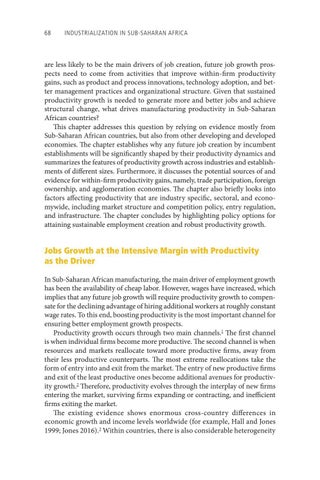68 Industrialization in Sub-Saharan Africa
are less likely to be the main drivers of job creation, future job growth prospects need to come from activities that improve within-firm productivity gains, such as product and process innovations, technology adoption, and better management practices and organizational structure. Given that sustained productivity growth is needed to generate more and better jobs and achieve structural change, what drives manufacturing productivity in Sub-Saharan African countries? This chapter addresses this question by relying on evidence mostly from Sub-Saharan African countries, but also from other developing and developed economies. The chapter establishes why any future job creation by incumbent establishments will be significantly shaped by their productivity dynamics and summarizes the features of productivity growth across industries and establishments of different sizes. Furthermore, it discusses the potential sources of and evidence for within-firm productivity gains, namely, trade participation, foreign ownership, and agglomeration economies. The chapter also briefly looks into factors affecting productivity that are industry specific, sectoral, and economywide, including market structure and competition policy, entry regulation, and infrastructure. The chapter concludes by highlighting policy options for attaining sustainable employment creation and robust productivity growth.
Jobs Growth at the Intensive Margin with Productivity as the Driver In Sub-Saharan African manufacturing, the main driver of employment growth has been the availability of cheap labor. However, wages have increased, which implies that any future job growth will require productivity growth to compensate for the declining advantage of hiring additional workers at roughly constant wage rates. To this end, boosting productivity is the most important channel for ensuring better employment growth prospects. Productivity growth occurs through two main channels.1 The first channel is when individual firms become more productive. The second channel is when resources and markets reallocate toward more productive firms, away from their less productive counterparts. The most extreme reallocations take the form of entry into and exit from the market. The entry of new productive firms and exit of the least productive ones become additional avenues for productivity growth.2 Therefore, productivity evolves through the interplay of new firms entering the market, surviving firms expanding or contracting, and inefficient firms exiting the market. The existing evidence shows enormous cross-country differences in economic growth and income levels worldwide (for example, Hall and Jones 1999; Jones 2016).3 Within countries, there is also considerable heterogeneity

